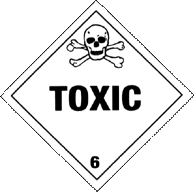Methomyl
- S-Methyl-N-(methylcarbamoyloxy)thioacetimidate
- Methyl N-{(methylamino)carbonyloxy}ethanimidothioate
- Ethanimidothioic acid, n-{{(methylamino)carbonyl}oxy}-, methyl ester

Methomyl | |
| |
| Formula | C5H10N2O2S |
| Structure |  |
| Description | White crystalline solid with slight sulfurous smell. |
| Uses | Nematocide, inceticide. |
| Registry Numbers and Inventories. | |
| CAS | 16752-77-5 |
| EC (EINECS/ELINCS) | 240-815-0 |
| EC Index Number | 006-045-00-2 |
| EC Class | Very toxic; Dangerous for the Environment |
| RTECS | AK2975000 |
| RTECS class | Agricultural Chemical and Pesticide; Mutagen |
| UN (DOT) | 2757 |
| Merck | 12,6062 |
| Beilstein/Gmelin | 2042050 |
| RCRA | P066 |
| EPA OPP | 549400 |
| Swiss Giftliste 1 | G-4584 |
| Austrailia AICS | Listed |
| New Zealand | Listed |
| Korea ECL | Listed |
| Properties. | |
| Formula | C5H10N2O2S |
| Formula mass | 162.21 |
| Melting point, °C | 78-79 |
| Boiling point, °C | 228 |
| Vapor pressure, mmHg | 5E-5 (25 C) |
| Vapor density (air=1) | 1.2946 |
| Critical temperature | 425 |
| Critical pressure | 31.8 |
| Density | 1.2946 g/cm3 (20 C) |
| Solubility in water | 58 g/L |
| pKa/pKb | 13,27 (pKa) |
| Partition coefficient, pKow | 0.60 |
| Hazards and Protection. | |
| Storage | Keep in a cool, dry, dark location in a tightly sealed container or cylinder. Keep away from incompatible materials, ignition sources and untrained individuals. Secure and label area. Protect containers/cylinders from physical damage. |
| Handling | All chemicals should be considered hazardous. Avoid direct physical contact. Use appropriate, approved safety equipment. Untrained individuals should not handle this chemical or its container. Handling should occur in a chemical fume hood. |
| Protection | Wear appropriate protective gloves, clothing and goggles. |
| Respirators | Wear positive pressure self-contained breathing apparatus (SCBA). |
| Small spills/leaks | Caution : Flammable. Avoid sources of extreme heat or ignition including sparks or fire. Methomyl will liberate toxic nitrogen and sulfur oxide fumes when heated to decomposition. (Non-Specific -- Carbamate Pesticide, Solid) Keep unnecessary people away; isolate hazard areas and deny entry. Stay upwind and keep out of low areas. Do not touch spilled material, or handle broken packages without protective equipment. Do not breathe dust, vapors, or the fumes from burning material. |
| Stability | Stable in neutral or slightly acidic solution aqueous solutions decompose slowly at room temperature, more rapidly on aeration, in sunlight, in alkaline media or at higher temperatures. |
| Incompatibilities | Incompatible with strong acids and bases, and especially |
| Fire. | ||||
| Fire fighting | (Non-Specific -- Carbamate Pesticide, Solid) Wear self-contained breathing apparatus.(Non-Specific -- Carbamate Pesticide, Solid) Use agent suitable for type of surrounding fire. Use water in flooding quantities as a fog. Use alcohol foam, carbon dioxide, or dry chemical. | |||
| Fire potential | Liquid formulations are flammable. | |||
| Hazards | When heated to decomposition, it emits very toxic fumes of nitrogen oxides and sulfur oxides. Do not subject liquid formulations to temperatures below 32F. | |||
| Combustion products | Fire may produce irritating, corrosive and/or toxic gases. | |||
| Health. | |
| Exposure limit(s) | TLV: ppm; 2.5 mg/m3 (ACGIH 1993). NIOSH REL: TWA 2.5 mg/m3 |
| Poison_Class | 2 |
| Exposure effects | Blurred vision, miosis, tremor, muscle twitching, convulsions, mental confusion, and coma may occur. Delayed peripheral neuropathy similar to that seen with organophosphates has been described in one case. Dystonic reaction may occur following parenteral injection. Methomyl has not been teratogenic in rats or rabbits, and did not affect fertility in multi-generation rat studies. <br>No data were available to assess the potential effects of exposure to this agent during pregnancy or lactation. <br>Methomyl affected sperm morphology in mice. |
| Ingestion | Nausea, vomiting, diarrhea, and abdominal cramping may be noted. |
| Inhalation | Dyspnea, rales, and pulmonary edema may occur. |
| Skin | Avoid any skin contact. See Inhalation. |
| Eyes | Pinpoint pupils may be seen. |
First aid |
|
| Ingestion | Do not induce emesis. Activated charcoal: administer charcoal as a slurry (240 ml water/30 g charcoal). Usual dose: 25 to 100 g in adults/adolescents. |
| Inhalation | Move victim to fresh air. Apply artificial respiration if victim is not breathing. Do not use mouth-to-mouth method if victim ingested or inhaled the substance; induce artificial respiration with the aid of a pocket mask equipped with a one-way valve or other proper respiratory medical device. Administer oxygen if breathing is difficult. |
| Skin | Remove contaminated clothing and jewelry. Wash the skin, including hair and nails, vigorously; do repeated soap washings. Discard contaminated clothing. |
| Eyes | Irrigate exposed eyes with copious amounts of tepid water for at least 15 minutes. If irritation, pain, swelling, lacrimation, or photophobia persist, the patient should be seen in a health care facility. |
| Transport. | ||
| UN number | 2757 |  |
| Response guide | 151 | |
| Hazard class | 6.1 | |
| Packing Group | I; II; III | |
| USCG CHRIS Code | MML | |